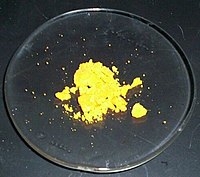Ferric chloride
 |
|||
|
|
|||
| Names | |||
|---|---|---|---|
|
IUPAC names
Iron(III) chloride
Iron trichloride |
|||
| Other names
Ferric chloride
Molysite Flores martis |
|||
| Identifiers | |||
|
7705-08-0 10025-77-1 (hexahydrate) |
|||
| 3D model (Jmol) | Interactive image | ||
| ChEBI |
CHEBI:30808 |
||
| ChemSpider |
22792 |
||
| ECHA InfoCard | 100.028.846 | ||
| EC Number | 231-729-4 | ||
| PubChem | 24380 | ||
| RTECS number | LJ9100000 | ||
| UNII |
U38V3ZVV3V 0I2XIN602U (hexahydrate) |
||
| UN number | 1773 (anhydrous) 2582 (aq. soln.) |
||
|
|||
|
|||
| Properties | |||
| FeCl3 | |||
| Molar mass | 162.2 g/mol (anhydrous) 270.3 g/mol (hexahydrate) |
||
| Appearance | green-black by reflected light; purple-red by transmitted light hexahydrate: yellow solid aq. solutions: brown |
||
| Odor | slight HCl | ||
| Density | 2.898 g/cm3 (anhydrous) 1.82 g/cm3 (hexahydrate) |
||
| Melting point | 306 °C (583 °F; 579 K) (anhydrous) 37 °C (99 °F; 310 K) (hexahydrate) |
||
| Boiling point | 315 °C (599 °F; 588 K) (anhydrous, decomposes) 280 °C (536 °F; 553 K) (hexahydrate, decomposes) partial decomposition to FeCl2 + Cl2 |
||
| 74.4 g/100 mL (0 °C) 92 g/100 mL (hexahydrate, 20 °C) |
|||
|
Solubility in acetone Methanol Ethanol Diethyl ether |
63 g/100 ml (18 °C) highly soluble 83 g/100 ml highly soluble |
||
| +13,450·10−6 cm3/mol | |||
| Viscosity | 40% solution: 12 cP | ||
| Structure | |||
| hexagonal | |||
| octahedral | |||
| Hazards | |||
| Safety data sheet | ICSC | ||
| GHS pictograms |
 
|
||
| GHS signal word | DANGER | ||
| H290, H302, H314, H318 | |||
| P234, P260, P264, P270, P273, P280, P301+312, P301+330+331, P303+361+353, P363, P304+340, P310, P321, P305+351+338 | |||
| NFPA 704 | |||
| Flash point | Non-flammable | ||
| US health exposure limits (NIOSH): | |||
|
REL (Recommended)
|
TWA 1 mg/m3 | ||
| Related compounds | |||
|
Other anions
|
Iron(III) fluoride Iron(III) bromide |
||
|
Other cations
|
Iron(II) chloride Manganese(II) chloride Cobalt(II) chloride Ruthenium(III) chloride |
||
|
Related coagulants
|
Iron(II) sulfate Polyaluminium chloride |
||
|
Except where otherwise noted, data are given for materials in their standard state (at 25 °C [77 °F], 100 kPa).
|
|||
|
|
|||
| Infobox references | |||
Iron(III) chloride, also called ferric chloride, is an industrial scale commodity chemical compound, with the formula FeCl3 and with iron in the +3 oxidation state. The colour of iron(III) chloride crystals depends on the viewing angle: by reflected light the crystals appear dark green, but by transmitted light they appear purple-red. Anhydrous iron(III) chloride is deliquescent, forming hydrated hydrogen chloride mists in moist air. It is rarely observed in its natural form, the mineral molysite, known mainly from some fumaroles.
When dissolved in water, iron(III) chloride undergoes hydrolysis and gives off heat in an exothermic reaction. The resulting brown, acidic, and corrosive solution is used as a flocculant in sewage treatment and drinking water production, and as an etchant for copper-based metals in printed circuit boards. Anhydrous iron(III) chloride is a fairly strong Lewis acid, and it is used as a catalyst in organic synthesis.
The descriptor hydrated or anhydrous is used when referring to iron(III) chloride, to distinguish between the two common forms. The hexahydrate is usually given as the simplified empirical formula FeCl3⋅6H2O. It may also be given as trans-[Fe(H2O)4Cl2]Cl⋅2H2O and the systematic name tetraaquadichloroiron(III) chloride dihydrate, which more clearly represents its structure.
Anhydrous iron(III) chloride adopts the BiI3 structure, which features octahedral Fe(III) centres interconnected by two-coordinate chloride ligands. Iron(III) chloride hexahydrate consists of trans-[Fe(H2O)4Cl2]+ cationic complexes and chloride anions, with the remaining two H2O molecules embedded within the monoclinic crystal structure.
...
Wikipedia



